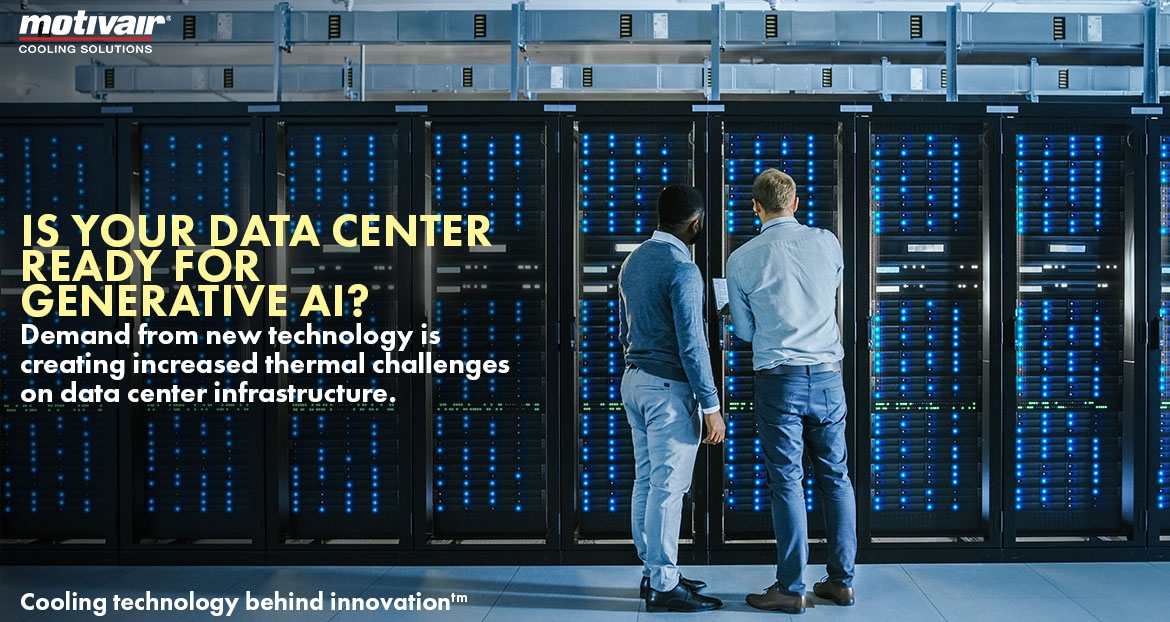Motivair Cool News
August 14th, 2023
Is Your Data Center Ready for Generative AI?

Artificial intelligence (AI) applications are growing by leaps and bounds. Whether it’s fraud prevention, virtual assistants, or personalized shopping, it’s becoming more and more intertwined in our daily lives.
With its rapid adoption and expansion also comes a tradeoff: It is pushing compute densities beyond previous forecasts, posing new and urgent thermal challenges for data center operators and owners, highlighting the need for the latest in direct liquid cooling technology.
THERMAL MANAGEMENT FOR AI & HPC
Deploying high-density cooling solutions is critical for data center owners & operators, not just from a customer-service standpoint but also an ROI perspective. Emerging technologies like Chat GPT or Google’s Baird will leave data centers with increased chip temperatures that need to be cooled correctly to function.
Data center cooling is primarily driven by air cooling and liquid cooling. The predominant liquid cooling methods involve either single-phase, where the fluid remains in a liquid state, or two-phase, where the fluid undergoes a repetitive cycle of boiling and condensing.
Data center operators can achieve effective cooling through:
- Air cooling: Utilizing Computer Room Air Handlers (CRAHs) and Computer Room Air Conditioners (CRACs) to transfer heat away from IT equipment.
- Single-phase immersion or Two-phase immersion: Submerging IT equipment in a dielectric, non-conductive fluid to dissipate heat efficiently.
- Two-phase direct liquid cooling or Single-phase direct liquid cooling: Implementing cold plates placed directly on top of computer chips to direct fluid flow and effectively remove heat from the components.
LIQUID COOLING OPTIONS FOR ARTIFICIAL INTELLIGENCE
Historically, Data centers have been air cooled and the surge in AI-integrated solutions is rapidly shifting the industry towards direct liquid cooling. Liquid Cooling market revenue will reach $2 billion by 2027 with a 60% CAGR from 2020 to 2027, according to a recent Dell’Oro Group report.
Enabling AI will require specific thermal technologies designed collaboratively with silicon manufacturers that can effectively and safely manage increased heat loads from new GPUs and CPUs, leveraging their tremendous compute power
- Coolant Distribution Units: Cool up to 2.3MW with Motivair’s portfolio of CDUs. Motivair’s CDUs represent the widest range and highest capacity of standard and custom OEM CDUs available.
- Dynamic™ Cold Plates: Scalable and patented technology that delivers thermal performance to +1,000 watts per processor for leading CPUs, GPUs, APUs, and FPGAs
- In-Rack Manifolds: Custom stainless-steel manifold that’s the interface between the cold plate loops in the servers and the CDU.
- ChilledDoor®: Server and rack agnostic active rear door heat exchanger that cools rack densities up to 75 kW per rack. Ideal for air-cooled, high-wattage processors like intel ice lake and sapphire rapids.
ADVANTAGES OF DIRECT LIQUID COOLING
Liquid cooling will be the most efficient and effective strategy to cool advanced processors and successfully deploy AI-related applications. Not only will it meet high-demand applications and tame high-heat processors, it can also help meet ESG goals.
Energy efficiency: Single-Phase DLC uses less energy compared to other data center cooling methods.
Peak performance: Single-Phase DLC offers the best performance and ability to scale out to at least 1,500 watts per processor.
Safety: Single-Phase DLC utilizes a water-based fluid, making it a safer option for employees and the environment.